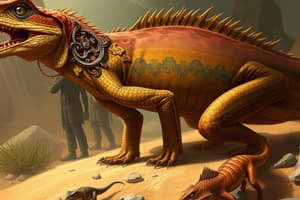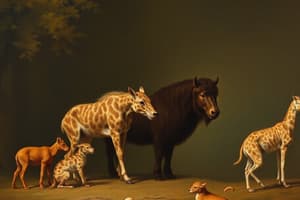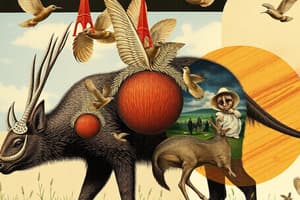Podcast
Questions and Answers
What is a primary adaptation of amniote vertebrates to protect embryos from desiccation?
What is a primary adaptation of amniote vertebrates to protect embryos from desiccation?
- Aquatic habitat for eggs
- Thick covering on eggs/embryos (correct)
- Constant temperature regulation
- Gaseous exchange with the environment
Which of the following best describes the role of the amniotic egg in reproduction?
Which of the following best describes the role of the amniotic egg in reproduction?
- Provides an aqueous environment for the embryo (correct)
- Increases the size of nitrogenous waste produced
- Allows external fertilization
- Eliminates the need for a protective covering
How do terrestrial animals typically maintain their body temperature?
How do terrestrial animals typically maintain their body temperature?
- By increasing body size
- By altering habitat preference
- By consuming more food
- Through metabolic activity and behavior (correct)
What type of waste do amniotes primarily excrete to conserve water?
What type of waste do amniotes primarily excrete to conserve water?
What is one of the constraints faced by sensory systems in organisms according to the document?
What is one of the constraints faced by sensory systems in organisms according to the document?
What mechanism do terrestrial tardigrades use to survive extreme environmental challenges?
What mechanism do terrestrial tardigrades use to survive extreme environmental challenges?
What is the primary reproductive strategy of rotifers in a moist environment?
What is the primary reproductive strategy of rotifers in a moist environment?
What adaptation do spadefoot toads exhibit to survive in desert environments?
What adaptation do spadefoot toads exhibit to survive in desert environments?
Which gas exchange system delivers air directly to tissues in insects?
Which gas exchange system delivers air directly to tissues in insects?
Why is breathing air advantageous compared to breathing water?
Why is breathing air advantageous compared to breathing water?
How do terrestrial organisms lessen evaporative water loss during gas exchange?
How do terrestrial organisms lessen evaporative water loss during gas exchange?
Which reproductive strategy allows rotifers to increase genetic diversity in dry environments?
Which reproductive strategy allows rotifers to increase genetic diversity in dry environments?
What challenges do terrestrial organisms face when breathing air?
What challenges do terrestrial organisms face when breathing air?
What is the main nitrogenous waste produced by reptiles, birds, and insects?
What is the main nitrogenous waste produced by reptiles, birds, and insects?
Which animal is part of the only completely terrestrial animal phylum?
Which animal is part of the only completely terrestrial animal phylum?
What is one adaptation terrestrial animals have developed to reduce water loss?
What is one adaptation terrestrial animals have developed to reduce water loss?
Which factor is NOT mentioned as a demand posed by the terrestrial environment?
Which factor is NOT mentioned as a demand posed by the terrestrial environment?
How do mammals adapt their excretion process to minimize water loss?
How do mammals adapt their excretion process to minimize water loss?
What is a significant challenge faced by small terrestrial animals regarding water loss?
What is a significant challenge faced by small terrestrial animals regarding water loss?
What do terrestrial animals primarily need to avoid desiccation?
What do terrestrial animals primarily need to avoid desiccation?
What adaptations do kangaroo rats have for surviving in arid environments?
What adaptations do kangaroo rats have for surviving in arid environments?
What does the term 'ureotelic' refer to in mammals?
What does the term 'ureotelic' refer to in mammals?
What environmental factor influences sensory modes and locomotion for terrestrial animals?
What environmental factor influences sensory modes and locomotion for terrestrial animals?
What role do extraembryonic membranes play in the amniotic egg?
What role do extraembryonic membranes play in the amniotic egg?
How do amphibians primarily facilitate gas exchange for their embryos?
How do amphibians primarily facilitate gas exchange for their embryos?
What aspect of amniotic eggs is crucial for conserving water during reproduction?
What aspect of amniotic eggs is crucial for conserving water during reproduction?
What is one main reason terrestrial animals engage in thermoregulation?
What is one main reason terrestrial animals engage in thermoregulation?
What describes the significance of a robust skeleton in terrestrial animals?
What describes the significance of a robust skeleton in terrestrial animals?
What is the process called when tardigrades form a resistant stage in response to dehydration?
What is the process called when tardigrades form a resistant stage in response to dehydration?
Which reproductive strategy do rotifers employ in stressed (dry) environments?
Which reproductive strategy do rotifers employ in stressed (dry) environments?
What mechanism helps terrestrial animals reduce water loss during gas exchange?
What mechanism helps terrestrial animals reduce water loss during gas exchange?
What is a common challenge faced by terrestrial organisms when utilizing lungs for gas exchange?
What is a common challenge faced by terrestrial organisms when utilizing lungs for gas exchange?
Which feature of the insect tracheal system aids in efficient gas exchange?
Which feature of the insect tracheal system aids in efficient gas exchange?
What adaptation allows desert-dwelling frogs to survive extended dry periods?
What adaptation allows desert-dwelling frogs to survive extended dry periods?
In the context of gas exchange, what is a disadvantage of breathing air compared to water?
In the context of gas exchange, what is a disadvantage of breathing air compared to water?
What is the primary benefit of the tracheal system in insects?
What is the primary benefit of the tracheal system in insects?
Which factor that affects terrestrial animals is primarily responsible for their need to maintain posture?
Which factor that affects terrestrial animals is primarily responsible for their need to maintain posture?
What is the primary nitrogenous waste produced by mammals to manage toxicity?
What is the primary nitrogenous waste produced by mammals to manage toxicity?
Which adaptation helps terrestrial animals minimize desiccation during gas exchange?
Which adaptation helps terrestrial animals minimize desiccation during gas exchange?
Which of the following groups of animals excretes nitrogenous waste in the form of uric acid?
Which of the following groups of animals excretes nitrogenous waste in the form of uric acid?
What is the significance of the Loop of Henle in mammals?
What is the significance of the Loop of Henle in mammals?
What evolutionary advantage do terrestrial environments provide to certain animal taxa?
What evolutionary advantage do terrestrial environments provide to certain animal taxa?
Which animal feature is crucial for minimizing water loss during respiration?
Which animal feature is crucial for minimizing water loss during respiration?
How does the size of insects contribute to their challenge in water conservation?
How does the size of insects contribute to their challenge in water conservation?
Which of the following mechanisms is primarily used by terrestrial animals to deal with desiccation?
Which of the following mechanisms is primarily used by terrestrial animals to deal with desiccation?
What physiological consequence arises from constant water loss in terrestrial animals?
What physiological consequence arises from constant water loss in terrestrial animals?
What is a crucial advantage provided by the amniotic egg during embryonic development?
What is a crucial advantage provided by the amniotic egg during embryonic development?
What characteristic of amniote vertebrates assists in preventing desiccation during reproduction?
What characteristic of amniote vertebrates assists in preventing desiccation during reproduction?
Which structure plays a significant role in gas exchange for amphibian embryos?
Which structure plays a significant role in gas exchange for amphibian embryos?
Why is uricotely an important adaptation for amniotes?
Why is uricotely an important adaptation for amniotes?
What adaptation helps support body weight in terrestrial animals?
What adaptation helps support body weight in terrestrial animals?
What is a primary adaptation that helps terrestrial animals deal with desiccation?
What is a primary adaptation that helps terrestrial animals deal with desiccation?
Which adaptation is specifically observed in kangaroo rats to aid in water conservation?
Which adaptation is specifically observed in kangaroo rats to aid in water conservation?
How do reptiles, birds, and insects primarily manage ammonia toxicity?
How do reptiles, birds, and insects primarily manage ammonia toxicity?
Which challenge related to water availability affects all terrestrial animals?
Which challenge related to water availability affects all terrestrial animals?
What mechanism helps minimize evaporative water loss through skin in terrestrial animals?
What mechanism helps minimize evaporative water loss through skin in terrestrial animals?
What is a significant consequence of a terrestrial environment for animal locomotion?
What is a significant consequence of a terrestrial environment for animal locomotion?
Which of the following is NOT a method terrestrial animals use for gas exchange?
Which of the following is NOT a method terrestrial animals use for gas exchange?
What is the benefit of having a longer Loop of Henle in mammals?
What is the benefit of having a longer Loop of Henle in mammals?
Which animal is classified as the only entirely terrestrial phylum?
Which animal is classified as the only entirely terrestrial phylum?
What strategy do insects employ to cope with desiccation caused by small body size?
What strategy do insects employ to cope with desiccation caused by small body size?
What process allows tardigrades to survive extreme dehydration by forming a resistant stage?
What process allows tardigrades to survive extreme dehydration by forming a resistant stage?
What mechanism do spadefoot toads use to minimize metabolical activity during prolonged periods of drought?
What mechanism do spadefoot toads use to minimize metabolical activity during prolonged periods of drought?
Which adaptation is crucial for internal gas exchange in terrestrial animals to prevent water loss?
Which adaptation is crucial for internal gas exchange in terrestrial animals to prevent water loss?
What phenomenon occurs when rotifers produce diploid zygotes that can withstand desiccation in harsh environments?
What phenomenon occurs when rotifers produce diploid zygotes that can withstand desiccation in harsh environments?
What disadvantage does gas exchange using lungs have compared to gas exchange in water?
What disadvantage does gas exchange using lungs have compared to gas exchange in water?
What is a key requirement for terrestrial life concerning water management?
What is a key requirement for terrestrial life concerning water management?
Which reproductive strategy helps ensure genetic variability among rotifers in stressed environments?
Which reproductive strategy helps ensure genetic variability among rotifers in stressed environments?
Flashcards
Terrestrial Animals
Terrestrial Animals
Land-dwelling animals descended from aquatic ancestors.
Desiccation
Desiccation
The loss of water through evaporation.
Water Conservation
Water Conservation
Mechanisms for reducing water loss in terrestrial animals.
Excretion
Excretion
Signup and view all the flashcards
Ammonia
Ammonia
Signup and view all the flashcards
Uric Acid
Uric Acid
Signup and view all the flashcards
Urea
Urea
Signup and view all the flashcards
Loop of Henle
Loop of Henle
Signup and view all the flashcards
Gas Exchange
Gas Exchange
Signup and view all the flashcards
Metabolic Water
Metabolic Water
Signup and view all the flashcards
Anamniotic Eggs
Anamniotic Eggs
Signup and view all the flashcards
Amniotic Egg
Amniotic Egg
Signup and view all the flashcards
Uricotely
Uricotely
Signup and view all the flashcards
Extraembryonic Membranes
Extraembryonic Membranes
Signup and view all the flashcards
Why Thermoregulation?
Why Thermoregulation?
Signup and view all the flashcards
Tardigrade Tun
Tardigrade Tun
Signup and view all the flashcards
Anhydrobiosis
Anhydrobiosis
Signup and view all the flashcards
Desert Spadefoot Toad Aestivation
Desert Spadefoot Toad Aestivation
Signup and view all the flashcards
Desiccation Avoidance
Desiccation Avoidance
Signup and view all the flashcards
Tracheal System (Insects)
Tracheal System (Insects)
Signup and view all the flashcards
Vertebrate Lungs
Vertebrate Lungs
Signup and view all the flashcards
Advantages of Air Breathing
Advantages of Air Breathing
Signup and view all the flashcards
Disadvantages of Air Breathing
Disadvantages of Air Breathing
Signup and view all the flashcards
Thermoregulation
Thermoregulation
Signup and view all the flashcards
Terrestrial Animal Transition
Terrestrial Animal Transition
Signup and view all the flashcards
Gravity's Impact
Gravity's Impact
Signup and view all the flashcards
Air vs. Water
Air vs. Water
Signup and view all the flashcards
Nitrogenous Waste
Nitrogenous Waste
Signup and view all the flashcards
Uric Acid Conservation
Uric Acid Conservation
Signup and view all the flashcards
Urea Excretion
Urea Excretion
Signup and view all the flashcards
Loop of Henle's Role
Loop of Henle's Role
Signup and view all the flashcards
Metabolic Water Production
Metabolic Water Production
Signup and view all the flashcards
Insect Desiccation Challenges
Insect Desiccation Challenges
Signup and view all the flashcards
Cryptobiosis
Cryptobiosis
Signup and view all the flashcards
Aestivation
Aestivation
Signup and view all the flashcards
Gas Exchange in Air vs. Water
Gas Exchange in Air vs. Water
Signup and view all the flashcards
Internalized Gas Exchange
Internalized Gas Exchange
Signup and view all the flashcards
Tracheal System
Tracheal System
Signup and view all the flashcards
Excretion with Limited Water Loss
Excretion with Limited Water Loss
Signup and view all the flashcards
Gas Exchange with Air - Trachea
Gas Exchange with Air - Trachea
Signup and view all the flashcards
Gas Exchange with Air - Vertebrate Lungs
Gas Exchange with Air - Vertebrate Lungs
Signup and view all the flashcards
Advantages of Breathing Air
Advantages of Breathing Air
Signup and view all the flashcards
Study Notes
Terrestrial Animals
- Animals originated in the oceans
- Terrestrial animals evolved from ancestors that independently left the aquatic environment
- Earliest recorded terrestrial animal (myriapod) was approximately 428 million years old, but the initial transition likely occurred earlier
- Relatively few animal taxa are purely terrestrial
- Examples include gastropods, arthropods (insects, arachnids, myriapods, crustaceans), nematodes, annelids, and amniote vertebrates
- Terrestrial environments provided many evolutionary opportunities
- Velvet worms and onychophorans are the only completely terrestrial animal phyla.
Conditions on Land
- Terrestrial environments present different demands compared to aquatic environments
- Gravity necessitates posture maintenance and locomotion
- Air is less dense than water, requiring adaptations for oxygen acquisition and locomotion
- Involves considerations of sensory modes, thermal properties, and the necessity of water as a limited resource
- Animals must be able to cope with exposure to UV radiation
Life on Land
- Desiccation must be avoided
- Animals must have mechanisms to counteract water loss and replace lost water from various loss mechanisms
- Examples include tolerance, excretion mechanisms, gas exchange adaptations, such as specialized internal organs (e.g., lungs, book lungs, tracheal systems)
Desiccation and the Environment - Terrestrial Animals
- Terrestrial animals are affected by the availability of water
- This influences their anatomy, behavior, and physiology
- Water loss occurs by evaporation, urine, and feces
- Animals may use thermoregulation to reduce water loss (e.g., sweating, panting)
Nitrogenous Wastes
- Ammonia, a toxic byproduct of amino acid and nucleic acid catabolism, requires removal or conversion
- Reptiles, birds, and insects convert ammonia into uric acid (semi-solid) for excretion, maximizing water conservation
- Mammals convert ammonia to urea for excretion, but this process necessitates water loss in urine
Desiccation and The Environment - Terrestrial Animals (Insects)
- Small size necessitates adaptations to counteract the higher surface area to volume ratio
- Waxy cuticles and spiracles (opening for air intake) minimize water loss.
Desiccation Tolerance
- Terrestrial tardigrades form a resistant state (tun) to endure harsh conditions (dehydration, temperature extremes)
Sexual Reproduction
- Sexual reproduction can result in genetic variability in organisms.
Aestivation
- Aestivation functions as a coping mechanism against harsh environmental factors (i.e. lack of water and high temperatures)
- Desert-dwelling species of toads and frogs exhibit this behavioral response.
More Requirements for a Terrestrial Life
- Protecting gametes and embryos from desiccation – this often requires internal fertilization
Gas Exchange with Air
- Animals utilize internalized gas exchange organs (lungs, book lungs, tracheal systems) to minimize water loss during gas exchange
Disadvantages of breathing air
- CO₂ diffuses into air less readily than water
- Respiratory surfaces must stay wet
Advantages of breathing air
- Air contains greater oxygen concentration than water; diffusion rate and process are faster than in water
- Less muscular effort is required to move air than water
Hard Skeletons - Endoskeletons
- Bones are composed of collagen that are mineralized by calcium phosphate crystals, highly vascularized and support weight
- Arthropod exoskeletons are composed of chitin, often impregnated with calcium carbonate, and comprised of plates (tergites) with joints to allow motion.
Hydrostatic Skeletons
- Fluid-filled compartments under pressure from muscles support the body shape
Aquatic Animals
- Water support reduces weight, rendering adaptations for support unnecessary.
- Desiccation is a less pressing issue under aquatic conditions.
Salt and Water Balance
- Marine tetrapods excrete excess salt through specialized salt glands
Homeostasis and Thirst and Survival
- Maintenance of a stable internal environment is critical for the survival of most organisms.
- Significant variables to regulate include temperature, pH, concentration of fluids and solutes, and nutrients.
Homeostasis - Negative Feedback Loops
- Homeostasis is maintained by regularly regulating physiological variables using a reference point (setpoint).
Body Weight (Allometry)
- Body mass grows disproportionately faster than the cross-sectional area of limbs in larger animals
- Skeletons are also affected by allometric growth - larger animals need proportionately stronger and larger limbs to support their increased size.
Aquatic Endoskeletons
- These are typically loosely associated (in comparison to terrestrial) with girdles and ribcages are not enclosed.
Water Potential
- Tendency of water to move, encompassing osmosis, hydrostatic pressure, gravity, humidity, other factors
- Osmotic potential (solute potential) - difference in solute concentration across a membrane; affects water movement
- Water pressure potential - mechanical component controlling water movement due to pressure (hydrostatic) on the water.
Osmoregulation
- Maintaining the appropriate solute concentrations inside and outside cells, especially in relation to their environment.
- Osmoregulators adjust their internal solute concentrations to match their environment, often with considerable effort
- Osmoconformers adjust their internal solute concentrations to match those of their surrounding environment
Tonicity and the Environment - Water Dwellers
- Marine bony fish have hypoosmotic systems (lower solute concentration than their environment) and thus lose water
- They gain ions through their gills, drink seawater to offset this loss, and produce dilute urine.
- Chloride cells in their gills pump ions out to maintain the precise ionic balance of their bodies.
- Freshwater bony fish have hyperosmotic systems (higher solute concentration than their environment) and gain water frequently
- These fish produce dilute urine and absorb ions to maintain their internal solute balance.
Osmoregulation in Animals
- Active regulation of water loss and gain
- Excretion of metabolic waste (toxins)
- Controlling salt (NaCl) / water / pH balance in extracellular fluids.
Major Actions of Water Loss Regulation
- Diffusion
- Actions of excretory tubules: filtration, secretion, reabsorption.
Osmoregulation in Animals
- Filtration: Water and solutes are moved into the excretory tubules
- Reabsorption: Valuable substances move from the filtrate back to the blood
- Secretion: Substances from blood are moved into the filtrate.
Ammonia (NH3) Excretion
- Ammonia is highly toxic
- Aquatic animals excrete ammonia directly into surrounding water
- Terrestrial animals produce urea or uric acid to minimize water loss
Protonephridium
- Filter fluid, using flame cells, and eliminating waste through channels
Metanephridium
- Filter coelomic fluid using vessels
Blood Vessels and Blood
- Arteries carry blood away from the heart
- Veins carry blood towards the heart
- Capillaries facilitate oxygen and nutrient exchange.
- Blood consists of plasma (extracellular fluid) and cellular components (RBCs, WBCs, and platelets).
Vertebrate Circulatory Systems
- Variations in circulatory systems are linked to the following: Whether gravity impacts blood flow, location of gas exchange (gills, lungs, or both), and thermoregulatory mechanisms (endothermy vs. ectothermy)
Ventilation
- Organisms use bulk flow (breathing) to exchange gases between the internal tissues and their external surroundings (air or water)
- The system will be influenced by the surface area and volume available to the organism
Atmospheric Composition and Pressure
- Atmospheric pressure decreases with altitude, but gas composition remains constant
- Partial pressures of individual gases in the atmosphere contribute to the total pressure exerted.
Partial Pressure Gradients
- Diffusion of gases relies on differences in their partial pressures
- Higher partial pressure gradients result in more rapid gas diffusion or exchange
Gas Exchange with the ECF
- The rate of gas exchange depends on the surface area for gas exchange, and differences in partial pressures
- Water and blood move in opposing directions to maintain a constant partial pressure difference across the exchange surface (countercurrent exchange)
Gas Exchange with the ECF
- Gas exchange surface area is correlated with body mass and metabolic rate.
- Organisms with high metabolic rates typically have larger gas exchange surfaces to compensate for increased oxygen and carbon dioxide consumption.
- Mammals and birds have a highly specialized respiratory system that efficiently distributes the needed materials
pH Regulation and Homeostasis
- Physiological processes are greatly affected by pH, which reflects the abundance of H⁺ ions in a solution
- Organisms have sophisticated mechanisms to maintain the correct pH for proper functionality
- These mechanisms involve the regulation of CO₂ and buffering processes that either conserve H⁺, or remove H⁺.
Studying That Suits You
Use AI to generate personalized quizzes and flashcards to suit your learning preferences.
Related Documents
Description
Explore the fascinating transition of animals from aquatic to terrestrial environments. This quiz delves into the evolution of terrestrial animals, their adaptations to land, and the unique challenges they face. Test your knowledge about the diversity of terrestrial taxa and their evolutionary significance.




